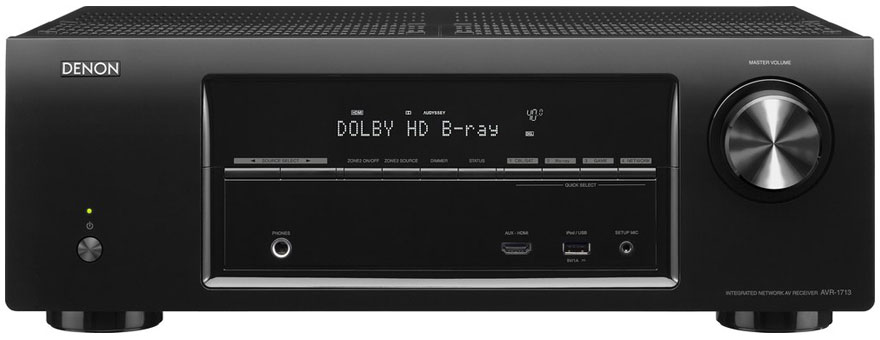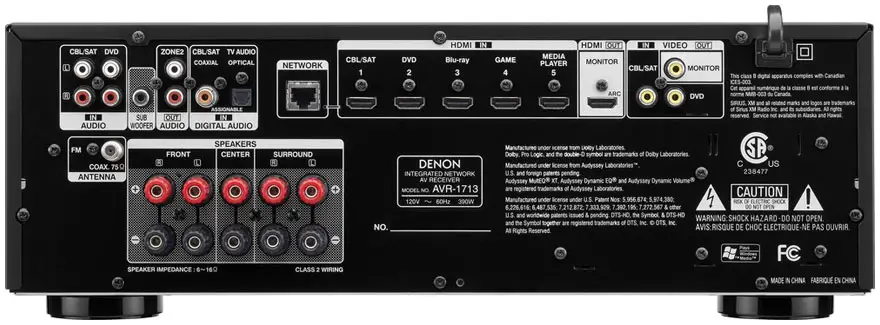Manufacturers make it a habit of announcing a new batch of AV receivers every year even though modern AV receivers should last for a couple of years. Average consumers probably won’t want to upgrade their AV receiver every year because even the most affordable ones can cost a couple hundred dollars. But new standards are starting to develop and consumers that are found of buying the hottest new gadgets like smartphones and tablets need to upgrade the devices in their living room at some point of time in order for these components to best interact with the next generation devices. Denon is one of the top brands of the AV receiver space and it intends attract consumers that don’t want to spend more than $600 by releasing four mainstream models including the Denon AVR-1713 which is positioned as one of the several midrange models.
Design
The Denon AVR-1713 is nearly a carbon copy of the more affordable Denon AVR-1613 with very minor differences. The dimensions (5.31″ x 17.09″ x 12.95″) and weight (18 pounds) are exactly the same and have the same ports on the front panel. The front panel features an HDMI port, USB port and phones jack. These three inputs are present to accept all sorts of portable devices ranging from iPods and iPhones to camcorders and digital cameras. The small setup mic jack on the right of the center panel is used for calibrating the AV receiver. There is only one large knob for controlling the master volume and a small power button on the far left of the AV receiver. The thin buttons laid out horizontally below the info display let you control the device in other ways such as setting the input select or creating custom functions out of the 4 “Quick Select” buttons available. The Zone 2 functions are unique to the Denon AVR-1713 and higher-end models because the AVR-1713 features multi-zone operation.
Another small difference between the Denon AVR-1713 and Denon AVR-1613 is the number of HDMI ports found on the back. The AVR-1713 features 5 extra HDMI ports which should be suitable for some of the larger home theater setups. This allows multiple media players and gaming consoles to be hooked up and you should still have room for a cable or satellite box.
One nice thing to note about the design is the anti-vibrations approach that Denon is taking with all of their AV receivers. By mounting the power transformers on the bottom, any sound that is processed won’t cause the AV receiver to vibrate which is one of the secrets behind optimizing the audio quality.
Below is the back panel layout. Click on image to enlarge for a clearer view.
Features
No matter what AV receiver you choose from the 2012 family of Denon components, you will get full compatibility with your 3D equipment as each HDMI has the latest 3D pass-through technology eliminating the need for a Blu-ray player to have 2 separate HDMI ports. This allows a more straightforward approach to setting up any home theater system with a 3D display and 3D Blu-ray player. When it comes to video quality, Deep Color and x.v.Color are supported so visuals should look nice.
Going to the primary functions, Denon has plenty of audio features that should be able to improve the overall sound experience across a wide variety of devices. While the Denon AVR-1713 supports the same 5.1-channel configuration as the other entry-level models, each of the five channels power up to 80 watts which is necessary since there are more HDMI ports and can handle multi-zone operation. Playing back Blu-ray titles shouldn’t be a problem because both Dolby TrueHD and DTS-HD are supported which are the two necessary decoders.
Several Audyssey audio technologies are deeply integrated to the AVR-1713 to further enhance the sound experience. One of the most convenient features out of these technologies is the Audyssey Dynamic Volume which keeps the volume levels normalized. When the volume needs to be turned down, some important audio details can be lost but the Audyssey DynamicEQ can preserve those details even if the volume levels are much lower. The last Audyssey technology that is featured plays an important role in speaker calibration. This feature is called Audyssey MultEQ and utilizes the setup microphone to analyze the room acoustics and speaker properties so the Denon AVR-1713 can make the necessary adjustments for the best possible sound quality.
But even with a good sound system, playing back audio files that are heavily compressed to reduce file size end up sounding awful. These compressed MP3 files are common in audio players because of their limited memory capacity. Since it is possible to connect these audio devices to the USB, HDMI or phones jack, it is only sensible for Denon to add a technology that focuses on these low-quality tracks. Fortunately the technology which is called the “Compressed Audio Restorer” actually works. Some of the missing details on some audio tracks were filled in so it sounds as if the bitrate was increased.
Setting up an AV receiver by yourself can be pretty difficult if the GUI isn’t very good but Denon managed to include a Setup Assistant to kick of its clear GUI. Though a simple step-by-step process, you can get all of your components to work with all of the advertised audio enhancements.
The Ethernet port is a nice addition to the AVR-1713 although the Internet connectivity features are more on the basic side. If you have a Blu-ray player or HDTV that can access NetFlix and other video streaming services, you will still use these functions because the Denon AVR-1713 focuses more on the audio services like Pandora and SiriusXM Internet Radio. Access to your Flickr account is possible as well.
But the bigger benefit of connecting the AVR-1713 to a wireless router through Ethernet is the network streaming capabilities that you can enjoy. If you have a Windows 7 or 8 PC or laptop, it should be DLNA 1.5-certified so you can easily share music directly to the AV receiver. AirPlay support is included as well which used to be reserved for the high-end models so you can use a number of Apple devices to wirelessly send any track or playlist in the iTunes library to the Denon AVR-1713.
Once you are ready to expand the sound experience to another room, you can just get a set of speakers and a power amp so you can connect it to the AVR-1713. Once connected, you can have two separate sources playing back from the same AV receiver.
Bottom Line
Because the Denon AVR-1713 costs about $150 more than the similar-looking AVR-1613, you have to decide if you will really need the extra HDMI port and multi-zone support. If you have plans in expanding your home theater system but won’t go beyond 5.1-channels, the AVR-1713 is the best way to go. For slightly smaller home theater systems, you can still enjoy the networking features in a single room while saving the $150 if you buy the $400 Denon AVR-1613 AV receiver.


